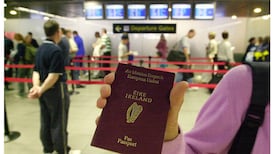My employer does not pay the €3.20 tax-free daily allowance for working from home, and I currently live in my parents’ house. As part of my rental agreement, I pay the electricity and gas bill in full. The bills are in my retired parents’ names but I have bank transfers to them for the amount of the bills. Can I claim the working from home tax relief? Ms KM
We bang on a lot about tax reliefs and the importance of claiming what you can but, until recently, the remote-working relief was something of a forgotten child.
In part that was because the sums accessible through the relief were fairly paltry. Revenue also did little to make it easy to claim.
But Covid changed all that. The remote worker, once an exotic niche species, became mainstream, and as the pandemic forced everyone to foot work-related bills for heat, light and broadband that were previously part of their employer’s responsibility in the office, the relief found itself in the consumer spotlight.
READ MORE
Despite the recent push by some larger firms to get everyone back into the office more often – or, indeed, full time – the reality is that most workers in both the public and private sectors operating in non-customer-facing roles are operating on the basis of a hybrid model.
[ The baffling working from home puzzle. Something doesn’t make senseOpens in new window ]
A recent analysis of claims for tax relief from PAYE workers published by the Revenue Commissioners show that remote working relief was the third most commonly claimed relief by taxpayers – after health expenses and the rent tax credit.
Still, confusion remains about just who can claim what and how. And it is not helped by the fact that there are two distinct ways of claiming the relief – with the benefit involved varying according to which route you follow.
Essentially, anyone who works from home on a full- or part-time basis, including hybrid workers, can claim back some of the costs they incur.
What you cannot do is claim for work you choose to bring home from the office with you to take a look at in the evenings, at weekends or over holidays. Revenue draws a fairly strict line between the two.
You refer to the €3.20 daily payment that a company can make to their employees tax free to cover the costs incurred. In my experience, you are far from alone in finding that your employer is not interested in entertaining this approach which was, until recently certainly, the more beneficial approach for workers.
I can see why as, especially where working from home might be somewhat irregular from week to week or month to month, it could cause payroll problems.
Where an employer does make the payment, it is exempt from income tax, PRSI and the universal social charge.
Where they pay more than that, the first €3.20 a day is tax free but the balance will be taxed.
And if your costs are higher than €3.20 a day, it is open to you to claim the excess separately from Revenue... but just make sure you deduct the first €3.20 from the claim for each day. If, as in your case, the employer will not entertain the tax-free payments, you can claim directly from Revenue.
And for those who pay income tax at the higher rate, the good news is that any relief granted will be at that rate.
But what can you claim? Revenue permits claims against the cost of electricity, heat and broadband. What they won’t cover is the cost of setting up your home office in the first place – such as buying a desk, work chair, laptop, printer and so on – though if you can persuade your employer to provide those, they will not be considered benefit in kind as long as they are used wholly or mostly for work.
How much can you claim? This is where it can start to wreck your head, especially if you are claiming for prior years.
For the last few years, you are entitled to claim 30 per cent of your bills for electricity, heat and broadband for those days that you are working from home. It sounds straightforward but it can be anything but.
First, let’s look at the calculation. If you work from home twice a week outside your holidays and your heating, light and broadband bills come to say €2,000 a year, it will look like this – (2,000 x 94) / 365 x 0.3 = 154.52
Let’s break that down. You multiply your annual bill (€2,000) by the number of days you work from home during the year (94). I’ve worked on the basis of two days a week, assuming you get five weeks in holiday from your employer.
You then divide that total by the number of days in the year – not forgetting that leap years require an adjustment. Finally you multiply that outcome by 0.3, which is 30 per cent.
Now, it doesn’t apply to you but if your employer did pay the tax-free per diem of €3.20 – which would be €300.80 for those 94 days – you would subtract that before you multiply anything by the 0.3.
In this case, the person in our example can claim €152.05 against their remote working costs. As this is allowed at their higher rate of tax and this taxpayer pays tax at 40 per cent, you multiply that €152.05 by 0.4 to give you €60.82, which is the amount of tax relief you’ll get.
If you pay tax only at the standard 20 per cent rate, it will come to only €30.41. Don’t go spending it all at once.
There has been growing pressure to adopt a more realistic approach to utility costs. Revenue’s thinking, presumably, is that your average eight-hour day accounts for a third of the 24 hours and hence allowing 30 per cent of your bills is fair.
But there are several issues with that. First, many people work more than eight-hour days. Second, to presume that the costs incurred in those eight hours are the same as those in the eight hours or so when people are in bed is entirely unrealistic.
If people were in the office, it is likely that those homes would be heated only briefly in the morning and then for five or six hours in the evening. On that basis, it would seem much more reasonable for Revenue to allow half your electricity, heating and broadband bills rather than 30 per cent.
Perhaps, Revenue assumes one parent is generally at home all day with their children. Quite apart from the fact that this does not cover people who do not have children or those whose children have grown and flown the nest, it ignores the reality for most couples that they both need to be working to pay the mortgage and household bills.
Leaving that aside, many families pay broadband as part of a package with their television costs. For those families using gas to heat their homes, cooking will also account for some of that bill.
Revenue says it will accept a “reasonable apportionment” of part of the bundled broadband bill to cover your broadband costs.
Calculation for 2021
The approach above has been in place since 2022 but, as you can claim back for four years before the current year, some people may still be claiming for 2021 this year. In that case, you can still claim 30 per cent of broadband costs but a skimpier 10 per cent of heat and light.
In terms of our formula for calculating the relief, you simply replace the 0.3 multiplier at the end with a multiplier of 0.1 for heat and light, and calculate the broadband cost separately.
But how do you go about claiming the relief? This is where we come to the nub of your specific question.
In your case, you have the bank transfers and that should suffice as the sums will match the bills and the payee will be the utility. That should suffice
Most people will claim in their annual tax return, which more and more of us are having to file each year as we look for relief from medical bills and other items such as rent or mortgage. But you can also claim on the go during the year.
The key thing is that, as the Revenue Tax and Duty Manual states, the employee claiming the expense must have incurred the cost – that is, they must have paid the bill.
There’s nothing in the manual to say that the bill must be in their name but, certainly for the years from 2022 onwards, you are expected to upload copies of the relevant utility bills online at myAccount or ROS. Clearly if the bills are in someone else’s name – such as a parent – Revenue will be likely to query the claim and you will need to show you have paid the bills.
In your case, you have the bank transfers and that should suffice as the sums will match the bills and the payee will be the utility. That should suffice.
If you are looking to claim the bills as you go through the year, you will need to upload the relevant utility bills to the receipt tracker that can be found in the PAYE services and Manage My Record section of the myAccount home page.
Click to add a new receipt, put in the date the bill was paid and the amount. You’ll have to select a category for the receipt from a drop down menu. Before you click to upload the receipt/bill, you will be asked if any third party reimbursed you for the cost.
Tax relief for working from home certainly remains out of kilter with the actual costs you are incurring compared with working from the office but that doesn’t mean you should ignore the chance of getting at least some of it back.
And there is nothing to stop you claiming as long as you are the person paying the bill, regardless of whose name is on the bill, as long as you can reassure Revenue that you are the one incurring the expense.
Please send your queries to Dominic Coyle, Q&A, The Irish Times, 24-28 Tara Street Dublin 2, or by email to dominic.coyle@irishtimes.com with a contact phone number. This column is a reader service and is not intended to replace professional advice

















